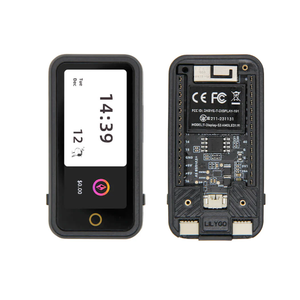
LilyGo T-Display-S3 AMOLED Touch is a development board based on the ESP32S3 microcontroller using architecture.
This board features a maximum CPU frequency of NaN MHz and 16MB flash memory.
About LilyGo T-Display-S3 AMOLED Touch
🚀 The LilyGo T-Display-S3 AMOLED Touch is a cutting-edge development board featuring an ESP32-S3 chip with integrated WiFi and Bluetooth 5 capabilities. It boasts a 1.91-inch AMOLED display with a resolution of 536x240 pixels, driven by an RM67162 controller, offering vibrant visuals for embedded applications. Now featuring capacitive touch support for intuitive user interactions. ⚡
📋 Technical Specifications
Complete technical specification details for LilyGo T-Display-S3 AMOLED Touch
🖥️ Display
🛰️ Connectivity
🧠 Microcontroller
LilyGo T-Display-S3 AMOLED Touch Pinout Diagram
Complete pin reference for LilyGo T-Display-S3 AMOLED Touch
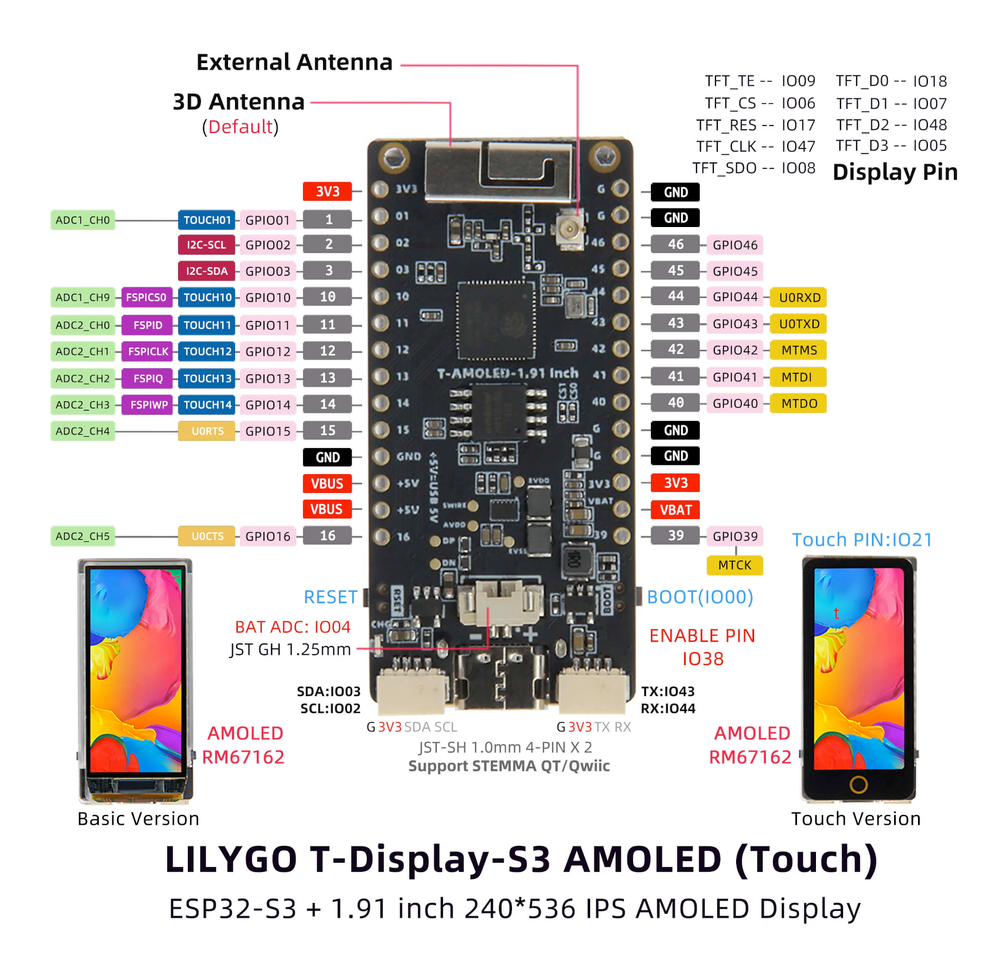
✅ Safe Pins to Use
These pins are safe for general GPIO usage without boot or system conflicts
💡 Why Are These Pins Safe?
⚠️ Pins to Avoid or Use with Caution
Reserved for critical functions. Misuse may cause boot failures, programming issues, or system conflicts.
Boot behavior & flash voltage
Low-level debugging interface
USB Serial/JTAG communication
Memory & PSRAM connections
Debugging & firmware uploads
| PIN | Label | Why Avoid | Type |
|---|---|---|---|
| IO0 | GPIO0 | Must be pulled high (default) or low (to enter UART download mode) at reset. Using it for other functions can interfere with boot mode configuration. | 🛠️ Strapping |
| IO3 | GPIO3 | Sampled at reset to select JTAG interface (USB Serial/JTAG controller vs. external pins). Improper use can disable external JTAG or alter debug interface. | 🛠️ Strapping |
| IO9 | FSPIHD | Connected to external flash (data/hold signal) on most modules. Not recommended for use as GPIO, since it must remain dedicated to flash communication. | ⚡ Flash |
| IO10 | FSPICS0 | Used to select the external flash chip. It is required for flash access and cannot be repurposed without losing flash connectivity | ⚡ Flash |
| IO11 | FSPID | Used as a data line for flash (and in-package PSRAM). It should not be used as GPIO when the flash/PSRAM is in use. | ⚡ Flash |
| IO12 | FSPICLK | Drives the flash (and PSRAM) clock. This critical signal must be reserved for memory and not used as general GPIO. | ⚡ Flash |
| IO13 | FSPIQ | Used as a data line for flash/PSRAM transfers. Not available for other uses when flash/PSRAM is connected. | ⚡ Flash |
| IO14 | FSPIWP | Connected to external flash (data/write-protect signal). Not recommended as GPIO because it’s reserved for flash operations. | ⚡ Flash |
| IO38 | FSPIWP | On flash-equipped chips, this pin is tied to the flash’s WP# (or D3) line. It should be avoided for other use, as it’s needed for flash operations. | ⚡ Flash |
Useful Links
Datasheets and resources for LilyGo T-Display-S3 AMOLED Touch
LilyGo T-Display-S3 AMOLED Touch Custom Pin Mapping
Pin configuration and GPIO mapping for LilyGo T-Display-S3 AMOLED Touch
| Pin | Function | ESP Pin | I/O Type | Description |
|---|---|---|---|---|
| 1 | 3V3 | 3.3V | POWER OUTPUT | 3.3V power output |
| 2 | GND | GND | POWER GROUND | Ground connection |
| 3 | 5V | 5V | POWER INPUT | 5V power input for the board |
| 4 | IO0 | A0 | BIDIRECTIONAL | GPIO, ADC pin, Touch, PWM |
| 5 | IO1 | A1 | BIDIRECTIONAL | GPIO, ADC pin, Touch, PWM |
| 6 | IO2 | A2 | BIDIRECTIONAL | GPIO, ADC pin, Touch, PWM |
| 7 | IO3 | A3 | BIDIRECTIONAL | GPIO, ADC pin, Touch, PWM |
| 8 | IO4 | BAT_VOLT | INPUT | GPIO, Battery Voltage Sense, PWM |
| 9 | IO5 | LCD_RES | OUTPUT | GPIO, LCD Reset, PWM |
| 10 | IO6 | LCD_CS | OUTPUT | GPIO, LCD Chip Select, PWM |
| 11 | IO7 | LCD_DC | OUTPUT | GPIO, LCD Data/Command, PWM |
| 12 | IO8 | LCD_WR | OUTPUT | GPIO, LCD Write, PWM |
| 13 | IO9 | LCD_RD | OUTPUT | GPIO, LCD Read, PWM |
| 14 | IO10 | SS | BIDIRECTIONAL | GPIO, SPI Slave Select, PWM |
| 15 | IO11 | MOSI | BIDIRECTIONAL | GPIO, SPI Master Out Slave In, PWM |
| 16 | IO12 | SCK | BIDIRECTIONAL | GPIO, SPI Clock, PWM |
| 17 | IO13 | MISO | BIDIRECTIONAL | GPIO, SPI Master In Slave Out, PWM |
| 18 | IO14 | TOUCH_INT | INPUT | GPIO, Touch Interrupt |
| 19 | IO15 | LCD_POWER_ON | OUTPUT | GPIO, LCD Power Enable, PWM |
| 20 | IO16 | TOUCH_SCL | BIDIRECTIONAL | GPIO, I2C Clock for Touch |
| 21 | IO17 | TOUCH_SDA | BIDIRECTIONAL | GPIO, I2C Data for Touch |
| 22 | IO38 | LCD_BL | OUTPUT | GPIO, LCD Backlight, PWM |
Default Tools & Configuration
Build and upload settings for LilyGo T-Display-S3 AMOLED Touch
| Setting | Value |
|---|
The LilyGo T-Display-S3 AMOLED Touch uses for uploads , and bootloader at .
Flash mode: | Boot mode:
Similar Boards
Other development boards with ESP32S3 microcontroller
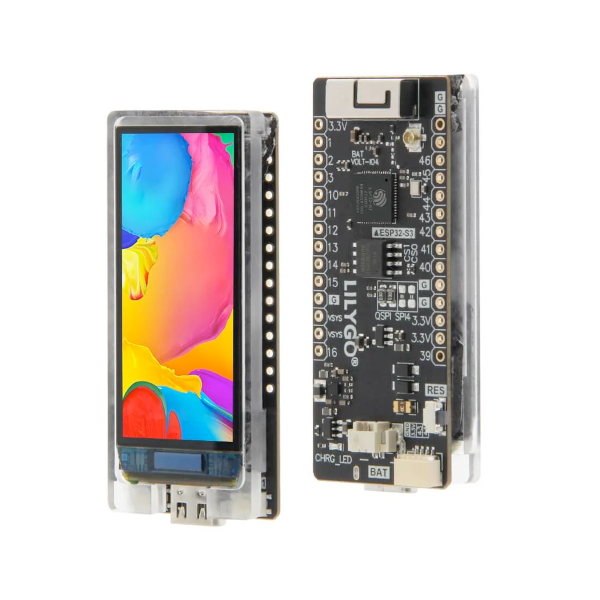
LilyGo T-Display-S3 AMOLED
LilyGo T-Display-S3 AMOLED development board is based on esp32s3 microcontroller and uses xtensa architecture.
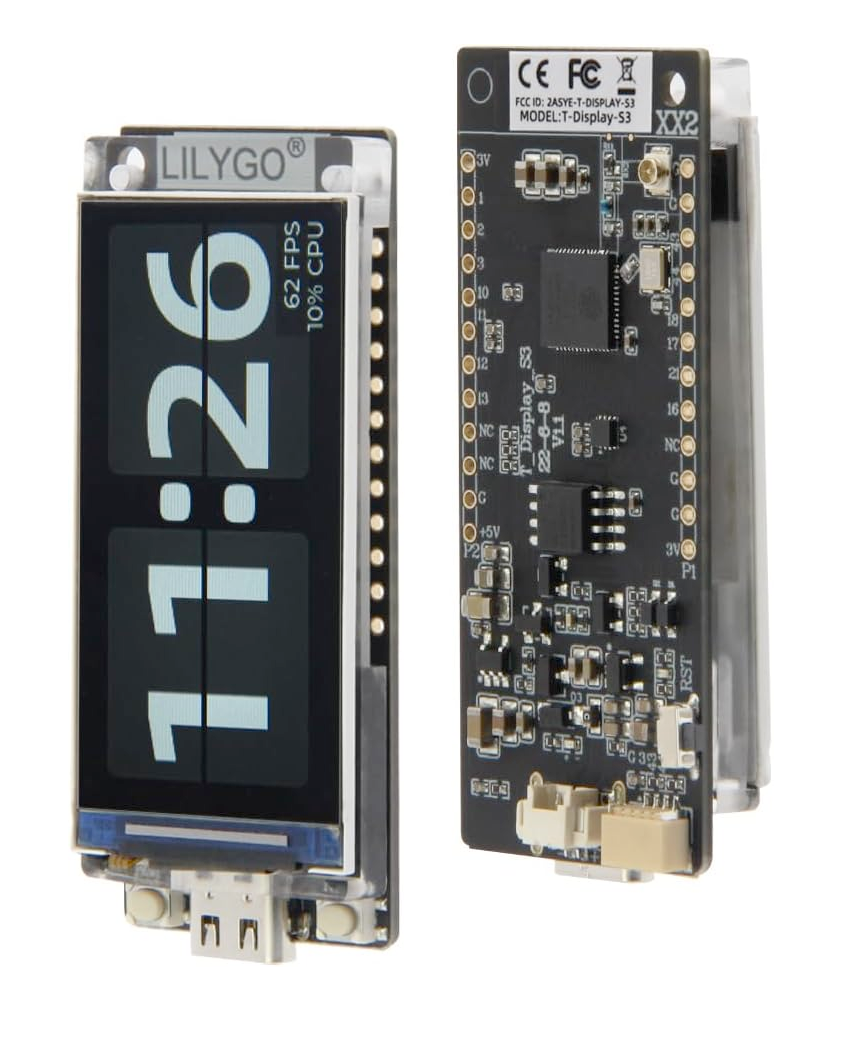
LilyGo T-Display-S3
LilyGo T-Display-S3 development board is based on esp32s3 microcontroller and uses xtensa architecture.
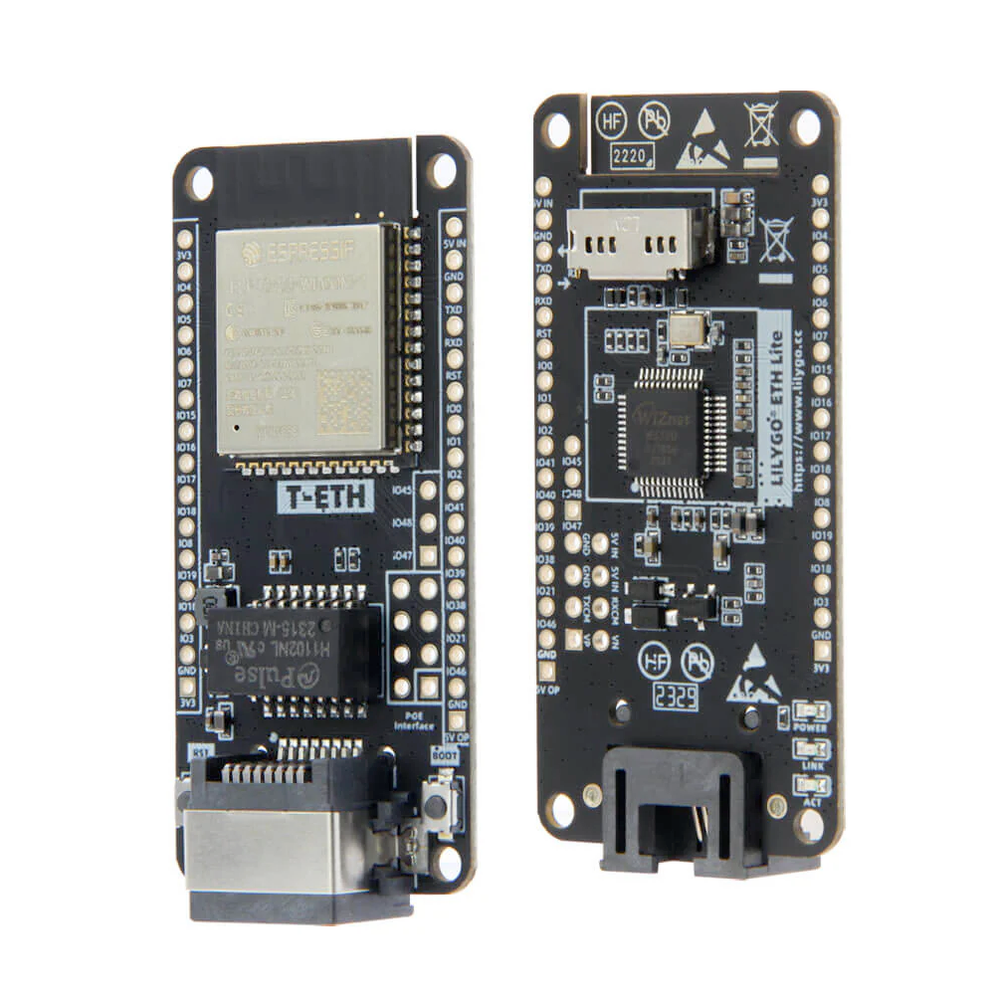
LilyGo T-Eth Lite
LilyGo T-Eth Lite development board is based on esp32 microcontroller and uses xtensa architecture.